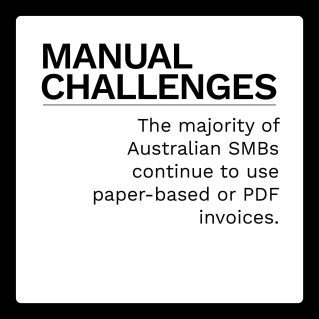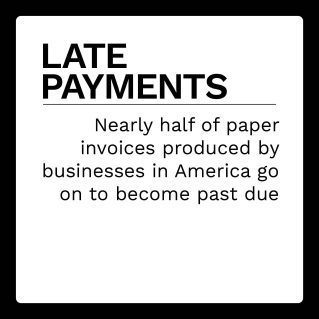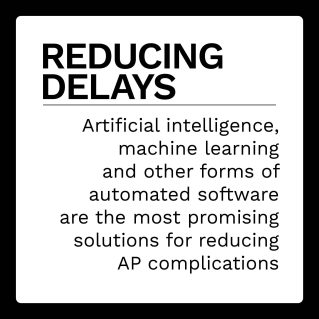Many businesses are implementing automation and digitization to reduce the amount of money, time and employee effort they expend on their accounts payable (AP) processes. Goals vary, with 61% of CFOs saying their primary objective in automating is to boost overall payments efficiency, while 45% hope to increase cash flow and working capital. Digitization and automation initiatives can significantly impact firms’ bottom lines, reducing processing costs per invoice from $6.30 to $1.45 on average. This is to say nothing of the substantial downstream benefits of improved capital management, better cash flow and timelier payroll — all keys to creating a healthy internal AP system.
In the latest “AP Automation Tracker®,” PYMNTS examines how the AP automation needs of large, innovative organizations are changing and why keeping pace with such changes is critical for AP leadership.
Around the AP Automation Space
Cross-border payments are a perennial pain point for businesses that operate internationally, resulting in several downstream issues and slow processing times. One of the major impacts is on cash flow management: If money is not available when it needs to be, companies can experience payroll problems, late payments to vendors and a host of other troubles.
A recent study found that 56% of U.S. businesses said cross-border payments innovation would improve their cash management — a sentiment echoed by 51% of U.K. businesses. One problem was the cost of these international payments, with 62% of U.K. businesses saying that reducing cross-border payments’ costs is one of the key benefits of innovation, and 54% of U.S. businesses agreed. Another benefit of improved cross-border transactions is cybersecurity, with 52% and 51% of businesses in the U.K. and the U.S., respectively, saying they expect those innovations to reduce fraud.
 Delayed payments have become widespread throughout the pandemic as businesses face economic struggles, reduced cash flows and other complications. The U.K.’s Small Business Commissioner, Liz Barclay, estimates that large corporations in the country currently owe small- and midsized businesses (SMBs) £23.4 billion ($31.2 billion) in late invoice payments, with two-thirds of SMBs reporting overdue invoices with no indication of when or whether they will be paid. These late payments have contributed to a supply shortage in the country, and two-thirds of SMBs say that a lack of supplies will adversely affect their output in the next quarter. The pandemic has introduced several other payment issues as well. One-third of U.K. businesses say they will be unable to repay their government-backed aid loans, for example, a total of £20 billion ($26.7 billion) that will likely never return to the public coffers.
Delayed payments have become widespread throughout the pandemic as businesses face economic struggles, reduced cash flows and other complications. The U.K.’s Small Business Commissioner, Liz Barclay, estimates that large corporations in the country currently owe small- and midsized businesses (SMBs) £23.4 billion ($31.2 billion) in late invoice payments, with two-thirds of SMBs reporting overdue invoices with no indication of when or whether they will be paid. These late payments have contributed to a supply shortage in the country, and two-thirds of SMBs say that a lack of supplies will adversely affect their output in the next quarter. The pandemic has introduced several other payment issues as well. One-third of U.K. businesses say they will be unable to repay their government-backed aid loans, for example, a total of £20 billion ($26.7 billion) that will likely never return to the public coffers.
For more on these and other stories, visit the Tracker’s News & Trends.
Microsoft on How Automation Powers Time and Cost Savings, Inspires Innovation
From small firms to some of the world’s best-known organizations, automation can help any business streamline processes, save money and ensure compliance. Tanner Busby, finance director in Procure to Pay strategy for Microsoft, was tasked with process innovation for one of the most influential tech companies in the world. Busby adopted this technology to streamline and simplify the work his team members and others at Microsoft do. This story illustrates the steps Busby and his colleagues took to help Microsoft focus its attention away from the nitty-gritty of processing payments and toward the next levels of innovation, both in payments and beyond.
Leveraging AP Automation to Improve Billing Processes
Capital management is a constant challenge for all types of businesses, requiring them to invest vast sums in managing cash flow, AP, accounts receivable (AR) and other related tasks. Problems range from incorrect invoices to lack of cash on hand to late payments, all of which demand considerable time and labor to correct. Many of the current problems with business-to-business (B2B) payments stem from their continued reliance on paper checks and manual processes.
In this in-depth examination of AP automation, we look at what innovators are doing to move beyond the basics, how they are doing it and what organizations need to do next.
About the Tracker
The “AP Automation Tracker®,” done in collaboration with Beanworks, examines how the burden of paper-based AP affects businesses’ capital management and cash flow. It also explores how automating AP systems can help businesses of all types reduce errors and delays and allow accounting staff to focus on the bigger picture to benefit the entire company.

